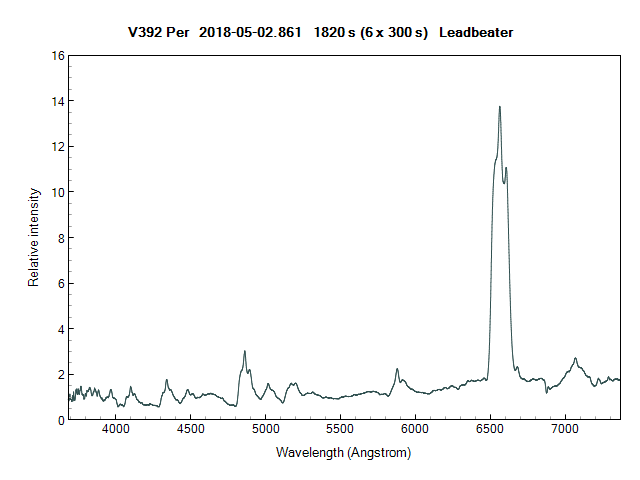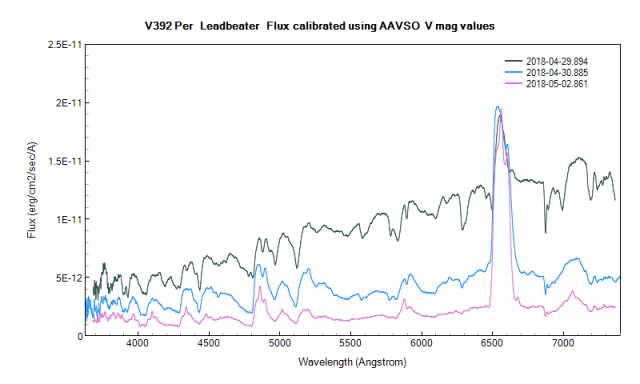› Forums › Variable Stars › Nova in Perseus
- This topic has 47 replies, 15 voices, and was last updated 5 years, 11 months ago by
 Denis Buczynski.
Denis Buczynski.
-
AuthorPosts
-
30 April 2018 at 4:48 pm #574016
 Gary PoynerParticipant
Gary PoynerParticipantIt would seem that a unique event is now occuring in Perseus. V392 Per, a dwarf nova with a range of 14.0-17.0V is now shining around magnitude 6.5 after undergoing a classical Nova eruption. To my knowledge this phenomenon has never been seen before.
The discovery was made by Yuji Nakamura, Kameyama, Mie, Japan on a CCD frame taken on 2018 Apr 29.4740 UT (limiting mag 12.5) using a 135mm f4.0 lens.
The position is RA 04 43 21.38 Dec +47 21 25.9 (2000.0)
Further details on ATel 11588 can be seen here . Robin Leadbeater has a spectrum here
A chart can be created with the AAVSO VSP, but you will need to show a wide field for the bright comparison stars (the ones used previously for V392 Per are all suited to it’s faint DNe type outbursts).
Gary
30 April 2018 at 6:36 pm #579395 David SwanParticipant
David SwanParticipantThanks for pointing this out – and I see Denis has put an image of the nova and field on his member’s page. Time to get my StarAnalyser out!
30 April 2018 at 7:30 pm #579396 Andrew RobertsonParticipant
Andrew RobertsonParticipantThanks for the alert Gary. Typical however, we’ve had loads of rain here in East Anglia in the last few days and still raining. If it does stop we’ll still have a full moon to take the edge off. Hopefully it will still be shining promnently when conditions improve.
Andrew
30 April 2018 at 10:22 pm #579397 David SwanParticipant
David SwanParticipantWow, it is bright!
1 May 2018 at 12:33 am #579398 Robin LeadbeaterParticipant
Robin LeadbeaterParticipantSpectra showing evolution between last night and tonight
(ALPY 600 R~520)
Robin
 1 May 2018 at 7:06 am #579400
1 May 2018 at 7:06 am #579400 Nick JamesParticipant
Nick JamesParticipantGreat stuff. Now if only we could get a clear sky in the southeast of England…
1 May 2018 at 11:16 am #579402 Gary PoynerParticipant
Gary PoynerParticipantLast nights (April 30) observations show V392 Per has faded by nearly a magnitude; 7.3-7.4 through the course of the evening.
Stick with it though, as the decline is usually pretty interesting – especially if it has an active transition phase.
Gary
1 May 2018 at 2:05 pm #579403 Richard MilesParticipant
Richard MilesParticipantYes, Gary – our witnessing a dwarf nova becoming a classical nova is unprecedented. And I see Robin’s spectrum shown on the ARAS Spectroscopy Forum:
http://www.spectro-aras.com/forum/viewtopic.php?f=5&t=2015
was of particularly high quality (given plenty of photons from a 6th magnitude source) and managed to report ahead of the professionals. Robin’s contribution was duly acknowledged by Wagner et al. in ATEL #11588:
http://www.astronomerstelegram.org/?read=11588
My request is – Can someone put a short news note out on the BAA frontpage so as to alert the membership, etc.?
Richard
1 May 2018 at 2:32 pm #579406 Gary PoynerParticipant
Gary PoynerParticipantSo, the Nova outburst of V392 Per is not unique after all. I found this interesting article describing Nova Cen 2009 (V1213 Cen) and it’s pre-Nova outbursts.
One other candidate (V1017 Sge – Nova Sgr 1919) was found to have a DNe type outburst 18 years before the Nova outburst and two following it, but although the light curve shape is the same as a classical Nova, V1017 Sgr is actually a symbiotic star and not a classical dwarf novae.
Maybe not unique then, but it’s still extremely rare – and interesting!
Gary
2 May 2018 at 12:15 am #579410 Nick JamesParticipant
Nick JamesParticipantAfter a nice day the evening was very hazy with a lot of cirrus but I did manage to get a picture of it in a small gap. The attached is a single 15s exposure at ISO800 with a 100mm f/2 lens at f/2.8. Capella is the bright star at lower left. The nova appears very red on this image.
2 May 2018 at 8:17 am #579411 Mike HarlowParticipant
Mike HarlowParticipantI managed to get a ‘quick look’ spectrum last night as the clouds parted and before the nova went behind a tree!
I used my 4.5 inch F/5 Newtonian with a 12 degree objective prism to image a 2.5 x 1.3 degree field containing the nova. It stands out clearly from the other stars in the field. Even with my un-modified Canon 550D DSLR the red H alpha emission is clear and explains the red colour of the nova seen in other images.
The bright star at top right is mag. 5.6 SAO39688, spectral type A0, showing H beta and H gamma lines.
2 May 2018 at 8:24 am #579412 Andrew RobertsonParticipant
Andrew RobertsonParticipantI had visuals on it last night from 22:15 hours to 23:15 hours. It was a balancing act between the sky getting darker as astro dark approached (22:58) but getting brighter as the almost full moon rose higher (moonrise 21:52) combined with target getting lower! I first detected it (surprisingly) in 7 x 50 binoculars just getting to grips with the field as I was going to use small fully manual scopes on Alt-Az mounts so I could move around to clear horizon obstacles. I then switched to a 72mm ED with full erecting prism and various powers starting off with a 24mm Panoptic giving x18 with a 3.8 deg FOV. I then switched to an Intes-Micro Alter 500 127mm F10 Mak-Cass for more light gathering. I didn’t see the mag 9.3 star (SAO39704) very near to it in the bins but I did in the 72mm and 127mm scopes. It was much brighter than the mag 9.3 star and I thought it had a hint of a red tint to it but very difficult to be sure on faint-ish objects. I then compared it to nearby stars SAO 39724 (mag 7.26) and SAO 39696 (mag 7.97), these were the two stars at the bottom of the Rhombus pattern. It wasn’t quite as bright as the m7.26 star but brighter than the 7.97, I put it at a 1/3 to 2/3 so estimated the brightness of V392 at mag 7.50.
Great fun, Andrew
2 May 2018 at 8:58 am #579413 Andrew RobertsonParticipant
Andrew RobertsonParticipantExcellent picture Nick, shows it off really well.
Andrew
2 May 2018 at 11:42 pm #579415 Robin LeadbeaterParticipant
Robin LeadbeaterParticipantHere is tonight’s spectrum. H alpha is really dominating the spectrum now as the continuum drops away. About 1/3 of the total flux in the visible range is now from H alpha.
Robin
 2 May 2018 at 11:57 pm #579416
2 May 2018 at 11:57 pm #579416 David SwanParticipant
David SwanParticipantI took some frames through the StarAnalyser 100 this evening. I’m pleased to see that my spectrum looks very like yours – the expert’s – but of course mine is lower res. The Halpha emission was indeed striking in the images!
3 May 2018 at 12:25 am #579417 Robin LeadbeaterParticipant
Robin LeadbeaterParticipantHere are my three spectra calibrated in absolute flux (using V mag values from the AAVSO database) rather than relative to the continuum. It is interesting to see how the peak flux at H alpha remains constant as the continuum falls away.
 3 May 2018 at 9:36 am #579418
3 May 2018 at 9:36 am #579418 Andrew RobertsonParticipant
Andrew RobertsonParticipantHad another good visual view last night. I reckon it’s dropped by about a magnitude from previous night.
Observed it with my 12″ D-K Mewlon and my large 28 x 110 binoculars. It was just detectable in the 11 x 70 finder. It was distinctly reddish in the 12″ but too small a FOV to make magnitude comparisons. The best overall view was in the 28 x 110 binoculars which I used to make magnitude estimates.
2nd May 2018, 21:30 hrs UT:Now dimmer than SAO 39696 (mag 7.97) but brighter than SAO 39704 (mag 9.3) In a ratio of 4 parts I put it -1 and +3 roughly = mag 8.3. Looked slightly brighter than SAO 39710 (mag 8.77) but midway between SAO 39734 (mag 8.88) and SAO 39742 (mag 8.14) which equates to approx mag 8.5. I would plum for mag 8.5.Forecast looking good for the weekend so an opportunity to see this plummeting each night, it will soon be fainter than the mag 9.33 star next to it. Great stuff.
Andrew
3 May 2018 at 10:37 am #579419 Robin LeadbeaterParticipant
Robin LeadbeaterParticipantThe ARAS spectroscopy group have a symbiotic relationship with Prof Steve Shore at the University of Pisa. (We take spectra and he explains what they mean). Today he puts this event into an astrophysical context.
http://www.spectro-aras.com/forum/viewtopic.php?f=5&t=2015&start=30#p10615
Cheers
Robin
3 May 2018 at 11:58 am #579420 Gary PoynerParticipant
Gary PoynerParticipantWe’ll make a VS observer of you yet Andrew. Give those fuzzies a break for a bit! 😉
Your estimate is in good agreement with other observers – fading quite quickly now. My own was 8.5 last night with 10x50B from dear old Brum!
Might have to take my life in my hands and observe from a nearby hill when it gets a bit lower. Bit dodgy up there of a night time, but needs must. Can I sneak out without the wife finding out though? Just as risky…
Gary
3 May 2018 at 12:59 pm #579421 Tim HaymesParticipant
Tim HaymesParticipantI imaged it last night with a Canon 60Da (105mm lens) and LPR filter – very red in the single frame (see inset). The magnitude is effected by the CCD and filter response and I made it about 8 – Sorry not very scientific, but clearly a remarkable object.

-
AuthorPosts
- You must be logged in to reply to this topic.
